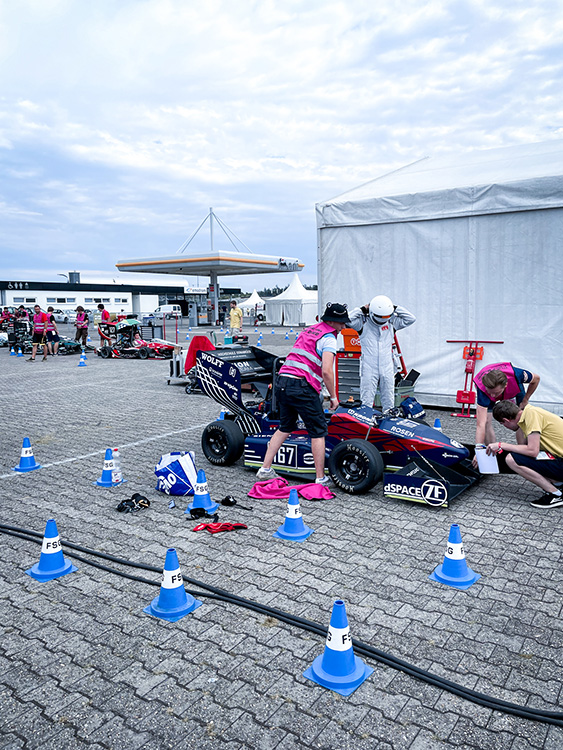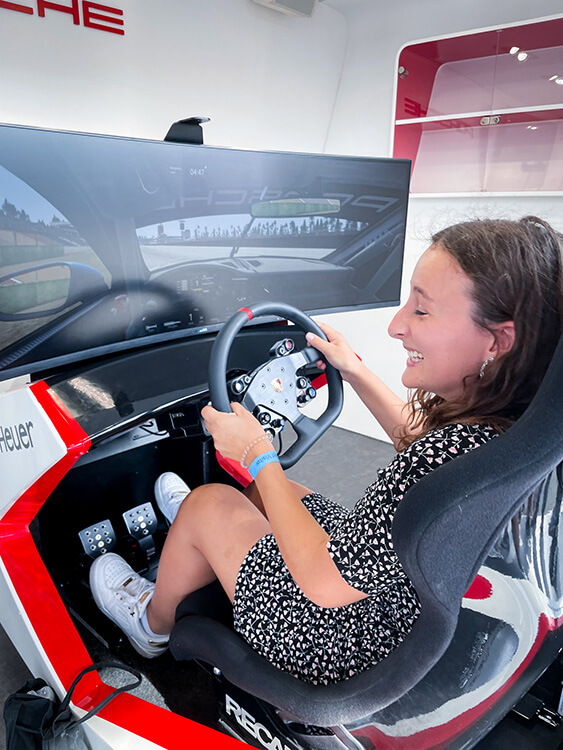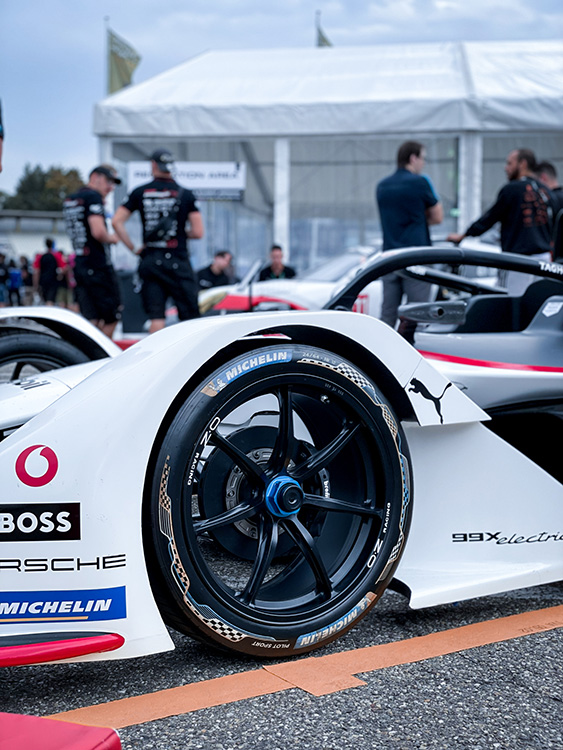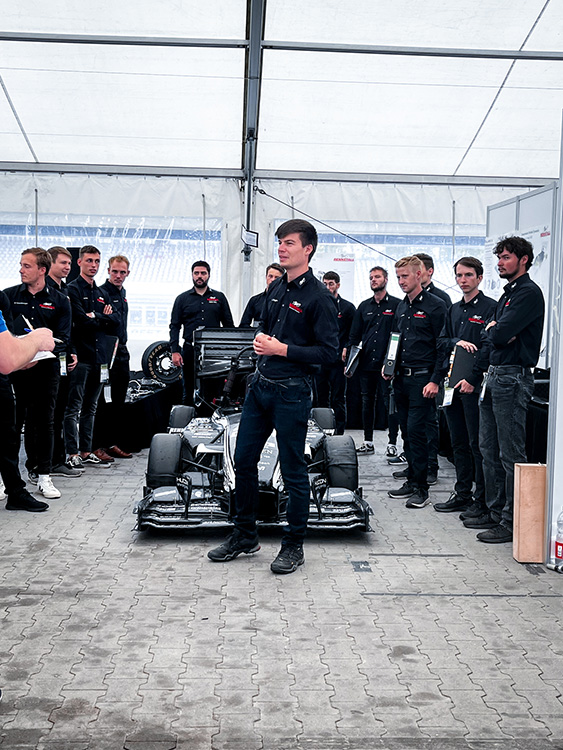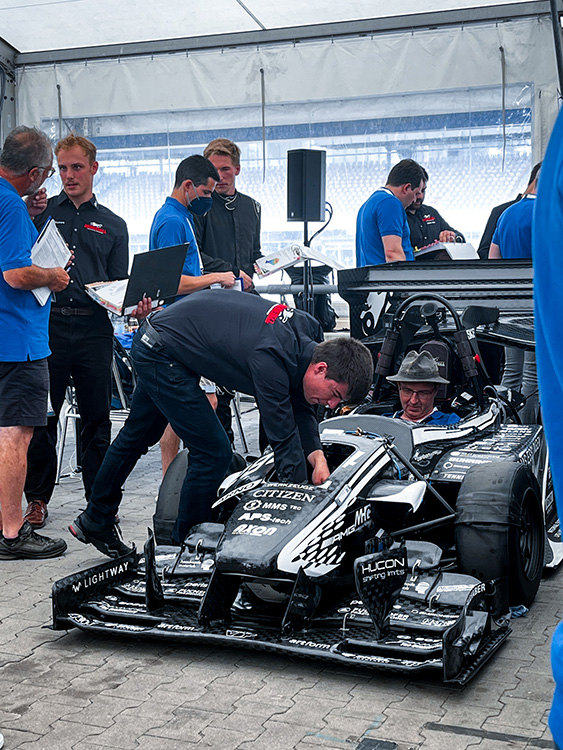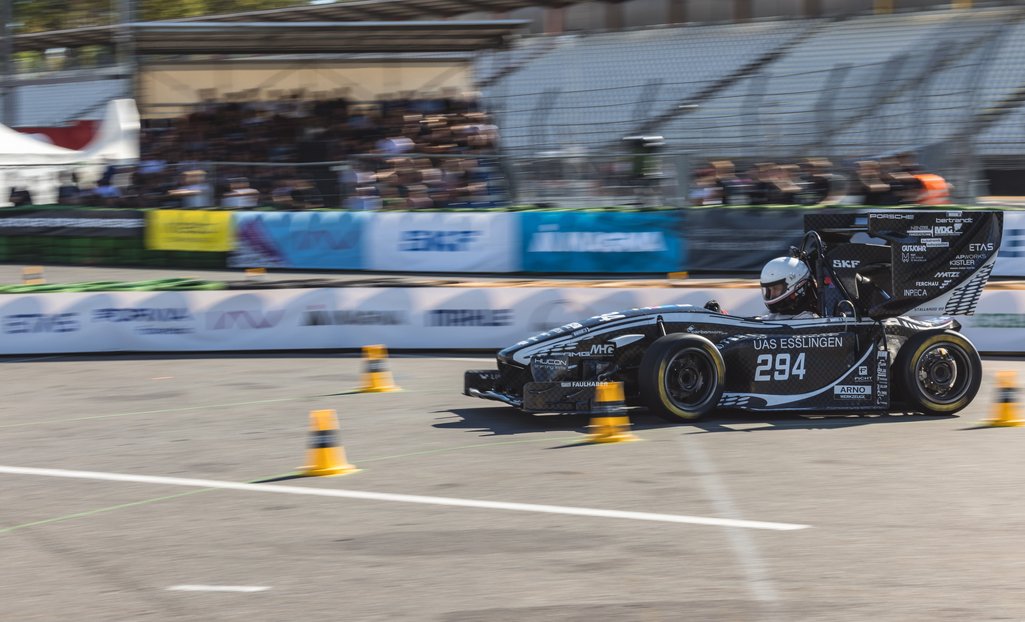
It’s Show Time at the Hockenheimring – Part 1
Ladies, start your engines! As guests of the Esslingen University of Applied Sciences, RAMPF employees Franziska Wasserberg and Rebecca Sanwald received an in-depth look behind the scenes of the spectacular racing competition Formula Student Germany. Technology from two RAMPF companies was also on show at the famous racetrack.
When December slowly but surely heralds winter, when it gets dark, cold, and wet, with dense wafts of fog rolling across the country, it is better to wallow in memories of summer. Together with my colleague Rebecca, I experienced a very special day in late summer, which we both still think back to with great enthusiasm.
Ready for a little journey back in time? Ready? Set. Go!
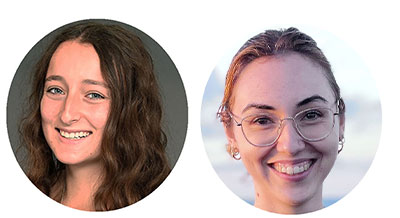
Rebecca Sanwald & Franziska Wasserberg
Rebecca Sanwald (left) is an industrial clerk trainee at RAMPF Polymer Solutions. During her training, she rotates within the RAMPF Group of companies and gets to know different departments. My name is Franziska Wasserberg, I work in the Corporate Communications department at RAMPF Holding.
As said – it is summer and therefore already bright and sunny in the morning as we get into the car at RAMPF's headquarters in Grafenberg. Arriving at our destination, however, it is drizzling down from a gray cloud cover. But that cannot dampen our spirits, because we are on a big mission today!
From the parking lot we head towards what we think is the entrance when a young man approaches us. “Hi, are you Rebecca and Franzi from RAMPF?”
It is Tim Ankele, who is our host today. The lettering Rennstall Hochschule Esslingen [Racing Team University of Esslingen] is embroidered in red and white letters on his black shirt. With a relaxed smile on his lips, he hands us two visitor wristbands:
Welcome to the Hockenheimring.
What brings us to this legendary racetrack? It is not Formula 1, but much better – Formula Student Germany (FSG)! Tim and his teammates are giving us a behind-the-scenes look at this exciting design competition for students, who also rely on technology from RAMPF. But we will get to that later…
Formula Student – born in the USA, racing worldwide
Formula Student started in the USA in 1979, when the Society of Automotive Engineers (SAE International) held an official design competition for prospective engineers. Since then, the objective of the event has been to offer participants a learning platform and the opportunity to apply and deepen the knowledge they have acquired during their studies.
However, not only the technical skills of the students are in demand – they also have to use and further develop their knowledge in the areas of project management and teamwork. As part of Formula Student, they gain valuable experience in motorsports and make initial contacts in the industry. The fact that all well-known companies from the racing, automotive, and supplier industries are present with large stands at the Hockenheimring shows how important Formula Student is for the promotion of young talents in motorsport.
Thanks to increasing awareness and great enthusiasm for the racing series, the events have now developed into a global competition. There are competitions in 19 countries with participants from more than 20 countries and 600 universities. In addition to the competition in Germany, the Esslingen racing team also competed in Austria (FSA), Croatia (FSAA), Hungary (FSEast & FSEaster), and Italy (FSAEItaly) in 2022.
Soapboxes? No. Sophisticated racecars? Yes!
The FSG Germany has been attracting motorsport-enthusiastic students from all over the world to the Hockenheimring since 2006. This year, almost 100 teams competed against each other. The students from Esslingen have now taken part fifteen times; in 2022, their team comprised around 50 people. The atmosphere is great, especially as the FSG is finally taking place again in full after a corona-related cancellation in 2020 and a reduced edition in 2021.
Anyone who thinks that Formula Student comprises the construction of soapboxes for a harmless race among students is completely on the wrong track – as this this video shows:
In fact, the student teams build technically adept, complex racecars. According to the current set of rules, the implementation of an autonomous system in all cars is mandatory, which means that they must be designed for two types of steering – the classic version with drivers and “driverless”, i.e. without a person behind the wheel. Of course, various safety systems are also in place, such as an emergency system with remote-controlled brake and signal lamps.
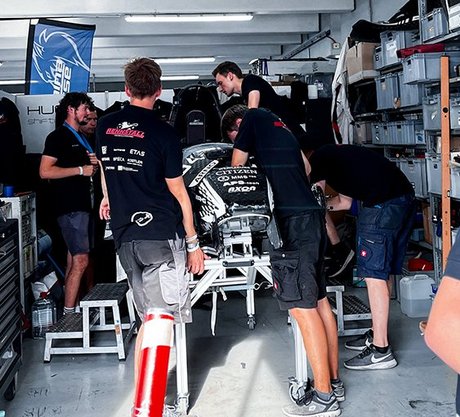
Prepared for all eventualities
The sun is now shining again at the FSG in Hockenheim. When we arrive at the team's pits, Rebecca and I are quite astonished. Here, on just a few square meters, the students from Esslingen have settled in for the seven-day event. It looks like a proper workshop. In the middle of the U-shaped structure is a frame with the team's racing car – the Stallardo'22.
We cannot believe that the students been staying here for only three days and not years! I ask Tim if they brought all of the equipment this themselves. He laughs and nods – “Of course, every event is always a logistical challenge. But we have to be prepared for everything.”
Although the team started developing their prototype almost a year before the competition season started, the car still has to be worked on during the event.
Today, on the third day of the competition, “scrutineering” is on the agenda, the technical inspection and verification of the car’s design structure. Before the cars actually hit the racetrack, they are put through their paces to ensure both the safety and equal opportunities of everyone involved. Only then are the teams allowed to take part in the dynamic disciplines, i.e. driving.
RAMPF times two
If the scrutineers discover flaws during the technical inspections, this must be rectified as quickly as possible. That is why it is so important to have all the necessary tools and spare parts available. This includes not only industrially manufactured parts such as screws or seals, but also custom-made products that are specially made for the Stallardo '22, such as carbon parts for the fairing of the car. The racing team makes these itself using molds made from RAKU® TOOL board material developed by RAMPF Tooling Solutions.
However, there is even more RAMPF technology. To produce the negative models from RAKU® TOOL boards, a milling machine is required – and that is where RAMPF Machine Systems comes into play.
The students face the following challenge – they are currently dependent on sponsors who produce the molds for them on their milling machines, and the students are not allowed to mill themselves. Therefore, milling can only be done with lead-time – and this is a problem if something has to be optimized shortly before a Formula Student event or if a part breaks.
Without a milling machine, it is not possible to produce new carbon parts at short notice. In addition, the number of carbon components have increased significantly over the past years, including the monocoque, rims, tanks, aerodynamic components, wishbones, and battery housings.
Safety first – before entering the dynamic disciplines, every driver must pass the driver egress. The test is about freeing yourself from the narrow cockpit of the vehicle within five seconds. That means – loosen the seat belts, remove the steering wheel, and jump out!
Project “Race to Mill”
Luckily, Tim and David Rommel came up with a great idea for a group project as part of their master’s course in resource efficiency in mechanical engineering. To enable the Esslinger Formula Student team to work more flexibly in the future, they decided to build their own three-axis milling machine.
And the foundation of this will be a machine bed made of EPUMENT® mineral casting from RAMPF Machine Systems.
To find out more on the status of the “Race to Mill” project and how the team from Esslingen did in the FSG, please read part 2 of the article “It’s Show Time at the Hockenheimring” on December 20, 2022!
Interesting articles
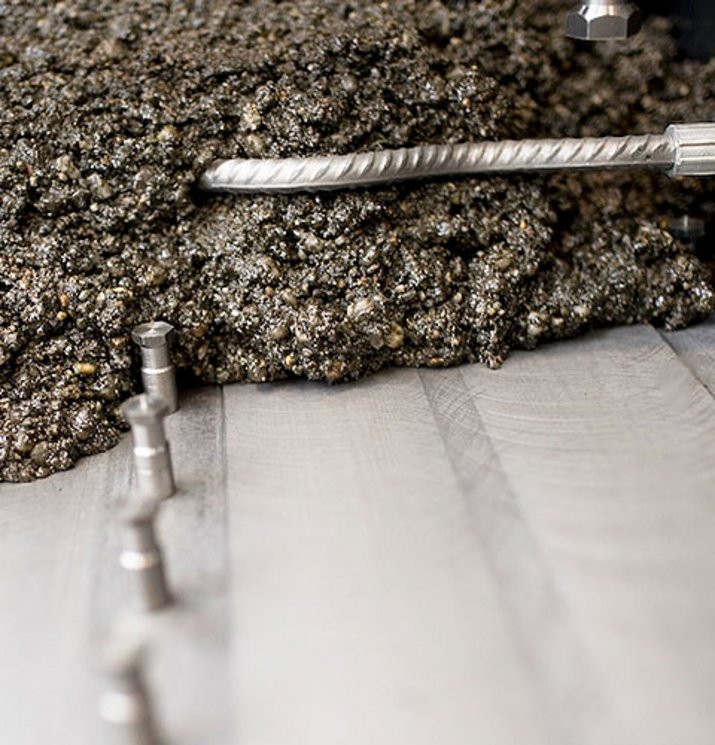
Verklebte Steinchen
Führende Maschinenbauer setzen auf eine Maschinenbasis aus Mineralguss. Warum? Das weiß Dr. Thomas Abel, Laborleiter bei RAMPF Machine Systems
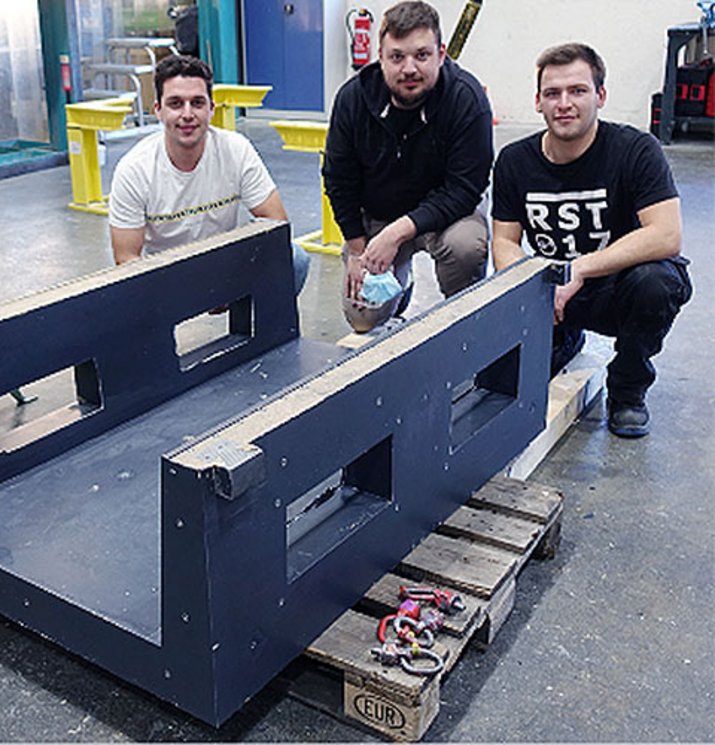
It’s Show Time at the Hockenheimring – Part 2
Fruitful exchange between university and industry – three Master students from the Esslingen University of Applied Sciences have launched the “Race to Mill” project in cooperation with RAMPF Machine Systems. They are developing a…

